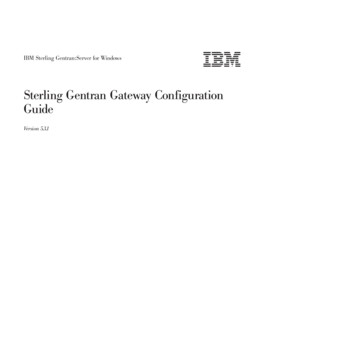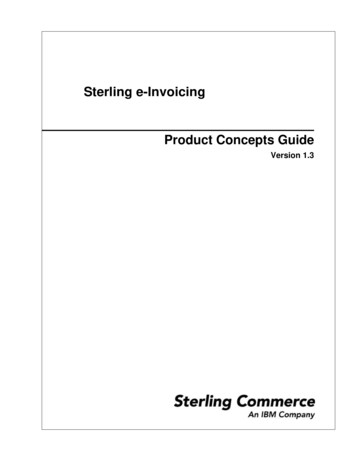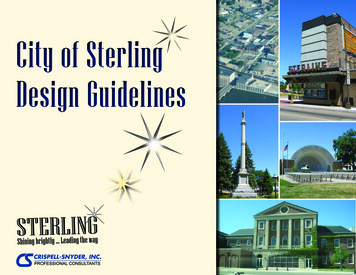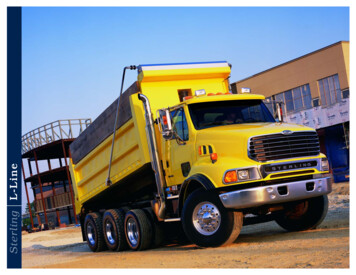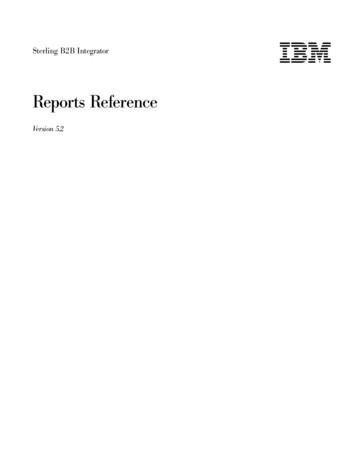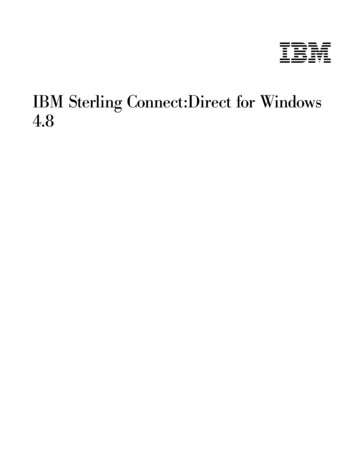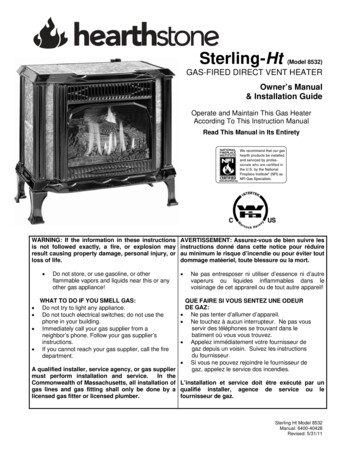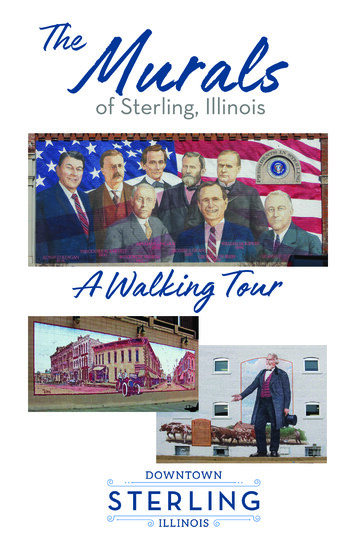
Transcription
MuralsTheof Sterling, IllinoisA Walking Tour
Itreally was an exciting time back in 1995, thestart of a dream to enhance our fair city by creatingbig, bold, beautiful historical murals. Our intentthen, which continues today, is to see to completionsuch projects through public donations, without anytax dollars being spent.The Sterling Mural Society has chosen some greatsubjects to depict our history. A lot of study andresearch went into each mural selection and finalmatching of subject with the best location in thedowntown area.These murals proudly reflect our past, one thatsilently proclaims to local citizens and visitors alike– “Visit us, enjoy us, be a part of us.”As Sterling continues to reinvent itself for thefuture, citizens new and old can be proud of thispast and use it as a base for continued growth andaccomplishment.John M. DillonNovember 1, 2006
The Murals of Sterling, Illinois1“Old Downtown” (1995)Muralists: Dan and Peter SawatzkyLocation: 1st Avenue & E. 3rd St.The location of East Third and Locust Streets in Sterling was quite memorable andcreated an exciting beginning to the Sterling Murals. The inspiration came fromphotographs dated from the early 1900s of the Martin Building, many stores, andthe Academy of Music which housed a reading room, a library, and offices.2“The Sterling, Dixon and EasternElectric Railway” (1995)Muralists: Dan and Peter SawatzkyLocation: 1st Avenue & E. 3rd St.From 1904 to 1925, the Sterling, Dixon and Eastern Railway served customersfaithfully, providing both interurban and local city service for the cities of Sterlingand Dixon, Illinois.The company obtained its ballast from a gravel pit located near Prairieville, and oddlyenough, when the highways were paved around 1920, much gravel was sold andhauled to road contractors. The sale of gravel meant badly needed revenue but atthe same time the SD&EER was hastening its end as paved roads increased travel byautomobile.3“Sterling Hydraulic Co.” (1996)Muralist: Dan SawatzkyLocation: 100 block of E. 3rd St.Depicts the Sterling Hydraulic Co. as it must have looked in the early 1870’s. TheSterling Hydraulic Company, organized in 1854 when work on the lower dam andrace commenced, brought about the development of industrial expansion after theCivil War and resulted in the growth of many businesses, particularly those located atthe intersection of Wallace and Locust Streets, including Spies, Zendt & Co.Implement Works (1872), Williams & Orton (1861), G.T. Elliot, Church & PattersonUnion Pacific & Sterling Flour Mills, Sterling Pump Co. (1863), Empire Feed Mill Mfg. Co.(1870), and Novelty Iron Works (Sterling School Furniture Co.) (1869).The mural illustration of businesses is from an 1872 Plat Book.
4“Janssen & Goeken Dry Goods& Grocery” (1996)Muralist: Dan SawatzkyLocation: 100 Block E. 4th St.The Janssen and Goeken Dry Goods and Grocery operated between 1898 and 1909,and began as a partnership between brothers Ihnke Ludwig Janssen (a/k/a Louie)and Friedrich Janssen. After his brother Friedrich died in 1898, the business becameJanssen & Goeken grocery & dry goods establishment. The store continued underthat name until the death of Louie Janssen in 1909. Ulrich P. Goeken (“U.P.”) wasa brother-in-law of Louie Janssen. Goeken sold the dry goods business to the LandisBrothers in 1924.The store was located in the building at 319-321 First Avenue in Sterling.5“Hezekiah Brink” (1997)Muralist: Don GrayLocation: E. 2nd St. at 1st AvenueIn November 1834, Hezekiah Brink became the first to build on the present site ofSterling. In 1835 he broke forty acres of land where Sterling now stands and raisedcrops. From 1855 to 1870, he engaged in general contracting, erecting most of thebrick houses in Sterling. He made all his own brick. The first religious society wasformed in the cabin of Brink in 1836, later becoming the Broadway MethodistChurch.The Mural today has been extended to include Major Sterling for whom the town ofSterling was named, due to a coin toss. (See Mural #15 for additional information.)6“Lady Zouaves” (1997)Muralist: Gary KirbyLocation: Brinks Circle at 3rd AvenueThe Sterling Lady Zouaves were trained, drilled and disciplined by Harold Ward untilthey became the national champions know as “The Girls Who Made Sterling Famous.”In 1919, they established a world record for wall scaling at the Spanish WarVeterans’ annual state encampment at Kewanee. Ten girls climbed over the ten-footwall in 30 seconds, including getting their guns over.This group was a very good advertisement for the city of Sterling. As they travelled,they handed out over 35,000 handbills furnished by the Sterling Chamber ofCommerce.
7Pioneer Steam Engine (1997)Muralist: Dave BarnumLocation: W. 2nd St. parking lot betweenLocust and Avenue AThe first train arrived in Sterling about July 22, 1855, and it was welcomed with agreat celebration. The railroad era for northwest Illinois from Chicago commencedin 1850 with the completion of service to Rockford, extended in 1852 to Freeport.The next departure was when the road was finished to Dixon, which became theshipping point and remained so for nearly two years. The road was finished toSterling and Morrison, and thence to Fulton on the Mississippi River in 1856.8The Sterling “Secret Six” (1998)Muralist: Don GrayLocation: 113 E. 3rd St.Perhaps the most controversial mural in Sterling is the one called The Secret Six.According to articles appearing in Sterling’s newspaper, The Daily Gazette, the mysterysurrounding the painting deals with the death of Sterling motorcycle policeman RobertCard, who was gunned down on August 12, 1930, as he was pursuing a car.Supposedly, prior to his death, Card had made comments to his aunt that his superiorswere out to get him. Nothing was ever proven, and the case never solved, but the familysuspected possible gangland ties with the Secret Six.The general impression is that the men of the Sterling Secret Six performed to thebetterment of community and state, even though local tales also connect thefamous, or possible infamous, set with murder and mayhem.Even though the mural is surrounded in mystery, the fact is that it represents the firstIllinois State Police unit in the Sterling district which included virtually all ofnorthwestern Illinois, from the Mississippi River to Chicago and north toWisconsin.
9“The First City Hall and FireStation” (1998)Muralist: Gary KirbyLocation: 110 W. 5th St. at Avenue BThe first City Hall was completed in the autumn of 1889 and occupied in November ofthat year. It was located at the corner of Fourth Street and First Avenue. The cost tobuild was 27,000. The first floor included space for police headquarters and fireman’squarters, plus the public library rooms. The second floors housed the Councilchamber, office of the City Clerk, City Engineer and Superintendent of Streets. In thebasement were the city prison, hose and fire apparatus room, and stables for horses.The electric automatic fire alarm bell was located in the tower. All departments werewell furnished and lighted with incandescent electric lights.10“Adelante” (1999)Muralist: Roberto ValadezLocation: Avenue C & W. 3rd St.“This mural touches on the whole notion of the immigrant experience and thewhole idea of coming to the United States in search of a better life,” says the artist,Roberto Valadez. “Our mural design has a lot to do with four central themes: work,faith, education and family.”The “Adalente” mural spans 130x18 feet. The first panel represents faith. The secondpanel illustrates agriculture and industry, depicting farms and the image of a ladlepouring molten steel, the kinds of work the immigrants found available to them inthe Sterling area. The third panel represents Hispanic participation in World War II.The fourth panel represent the “Silver City” district in Sterling from the 1940s and1950s; it was made up of converted railroad boxcars located near the steel mill. The lastpanel symbolizes educational and other employment opportunities.
11“Ringling Brothers Circus Fire”(2000)Muralist: Mark EbersoleLocation: 300 block of 2nd AvenueApril 12, 1922 – Five minutes before the doors to Ringling Brothers Circus were tobe opened, blazing shingles from the Martin Barn set fire to the big circus tent. It issaid that 25,000 people were assembled on the grounds. Before the flames could beextinguished, everything under the canvas roof was destroyed with the possibleexception of a few tiers of seats down low.Shortly before 1 o’clock the Martin Barn, located northwest of the big tent, wasdiscovered to be on fire and a still alarm was sent to the fire department. A strongnorthwest wind soon had blazing shingles flying in the air.12“Great Northwestern Fair” (2001)Muralist: Don GrayLocation: Locust at W. 5th St.Mr. and Mrs. Samuel Albertson owned and managed the property until a group ofbusinessmen bought the Woodlawn Mineral Springs Resort in 1898 and developedthe Great Northwestern Fair, an annual event that attracted large crowds with itsvariety of events.A large half-mile track was constructed with a judges’ viewing stand andamphitheater for spectators. Many famous race horses were brought to Sterling torace, including Dan Patch and Minor Heir. In addition to the attraction of carnival rides,concession stands, side shows, balloon ascensions, races, picnics and dancing, was thepopular “Shooting the Chutes.”01/2019
13“First Flyover” (2003)Muralist: Dan SawatzkyLocation: W. 5th St. at Locust St.The first airplane flight over Sterling in the fall of 1910 was piloted by Eugene Elyof Davenport, Iowa. He was a member of the Glen Curtis Exhibition Team, a groupwhich promoted aviation. Like many early “barnstormers,” he owned his plane andwas self taught. He traveled from town to town so that people could see thatairplanes would actually fly.The plane arrived in a railroad boxcar and was assembled in 55 minutes. The motorwas rated at 52 mph. At the end of the flight he would disassemble the plane and moveon to the next town.14“First Avenue Bridge” (2003)Muralist: Dan SawatzkyLocation: Avenue C at Avenue BThe first bridge structure was erected five years before the Civil War, but it wasshort-lived, carried away in flood waters of 1857. In 1863, a stock company, theSterling Bridge Co., was formed to erect a toll bridge, to be located at Avenue B usingPicnic Park, now Lawrence Park, as a mid-point to the shore on the other side. It wasnot until 1876 that a “free” bridge was built by residents of Sterling at the foot of FirstAvenue to a point directly across the river to the Rock Falls shore. The bridgecontinued to serve the twin cities until 1923, when construction of a new bridgebegan.The new bridge design which replaced the old iron super-structure included a subwayand outlets for Lawrence Brothers’ and National Manufacturing Co. shops, as wellas the turn into Wallace Street, improving access to the two factories for trucks andvehicles. The bridge opened to traffic December 5, 1924.Another overhaul began in September 1980 to widen the bridge, putting in a newsuperstructure and deck; the project was completed in November 1982 to the tune ofnearly 4.6 million.The mural is based on an 1896 photograph courtesy of the Sterling-Rock FallsHistorical Society.15“Major Sterling & the Coin Toss”(2004)Muralist: Don GrayLocation: 100 Block of E. 2nd St.The event used to name the city whenChatham & Harrisburg united.It’s not really all that complicated. Upon the toss of a few coins, the town was namedSterling. Stranger things have happened.
The town of Sterling was a consolidation of two settlements, Harrisburg and Chatham.The towns of Harrisburg and Chatham were rivals until a common interest demandedthrowing aside personal feelings and uniting for the common good.On this point, Worthington and Brink represented Harrisburg, and Wallace and Mason,Chatham. Mr. Brink wanted Pipsissiway, and to end the debate a proposition wasoffered to toss coins at a Broadway dividing line, with the coppers determining theside of the street the county building would be situated. The winners would alsohave the right of naming the city.Wallace and Mason won the toss and agreed on the name Sterling. Hugh Wallace,the first lawyer in town, chose the name after his friend Major Sterling. Actually,Major James Sterling, a man of excellent reputation, never lived in Sterling, and thetitle of Major was honorary, not military.16“The Presidents Corner” (2005)Muralist: Don GrayLocation: 1 E. 3rd St.Eight U.S. Presidents who visited Sterling are painted on the west side of the MartinBuilding.July 18, 1856 - The first visitor, Abraham Lincoln, who, as a lawyer, delivered a twohour speech on behalf of John C. Fremont who was the first candidate of the newRepublican Party.September 16, 1880 – The former general and President Ulysses S. Grant and hiswife, Julia, came to Sterling on the occasion of the Whiteside Fair.1896 – Republican William McKinley made a brief stop in Sterling during thecampaign for his presidency.1900 – Theodore Roosevelt had gained fame as a leader of the Rough Riders during theSpanish-American War two years earlier.1912 – Democrat Woodrow Wilson made a campaign stop. It is said that in a votetaken at a Whiteside County teacher’s institute he was the top vote getter amongwomen.August 30, 1920 – Franklin D. Roosevelt visited Sterling as a DemocraticVice-Presidential candidate.February 24, 1976 – Ronald Regan returned to the county of his birth, arriving inSterling from Tampico.September 20, 1979 – George H.W. Bush kicked off his presidential campaign atHarvey Arabian Farms.An Historical Sidelight:Visit the statue of Abraham Lincoln in Propheter Park at the corner of Sixth Avenueand Seventh Street. It was erected in 2006 in honor of his visit and speech inSterling 150 years earlier on July 18, 1856.
17“Sarah Worthington” (2006)Muralist: Don GrayLocation: alleyway of 400 blockbetween Locust St. & 1st AvenuePortrays the first teacher in Sterling, ca. 1838“Among the early settlers of the town of Sterling, IL, no name better deservesattention than that of the first Mrs. Worthington of her distant day. She not only borenobly all the hardships and privations of the usual pioneer wife and mother of fourchildren, but she was also the organizer and teacher of the first school in the little newtown and she gave Sterling its first impulses toward education, art and culture ingeneral.“Madam Worthington started in her home the first school in Sterling away back in1838. After a time the citizens built on Broadway a school house which became thefirst public school in the town.“All in all, she is abundantly entitled to her place as the first woman to promoteeducation and culture in this community, and there seems to have been no onewoman of our city since her so brilliant and versatile as this first teacher, first poet,first artist, loyal friend and true patriot. Sarah McShane Worthington.”Source: Excerpt from Old Home Town Column, Daily Gazette August 5, 1933.18“American Legion Post 296” (2007)Muralist: Jennifer BoekeLocation: 601 1st AvenueHonors all veterans and specifically publicservices performed by Sterling Legionnairessince 1919.American Legion Post 296 was organized in 1919 after World War I by five prominentSterling citizens: Keith Benson, Charles Larson, Leo Wahl, Edward Wahl and PhilipWard. Its preamble, which begins “For God and Country, we associate ourselvestogether ” is a heartfelt dedication to Freedom and Democracy by all veterans andLegionnaires, for the home, community and country in which they reside.Several printed references and more than 30 photographs were used to develop theconcept of the Legion Mural, covering such subjects as the Color Guard, Rifle Squad,Women’s Auxiliary, Flag Presentation at funerals, Drum Corps, a WWI Cannondonated by the Government, and the Memorial Day Wreath presented each year atthe Soldier’ Monument in Central Park.
19“The Lincoln Highway RadioShow” (2013)Location: Corner of Locust & E. 5th St.A gift from the Illinois Lincoln Highway Coalition, this Mural is the 34th in a series oflarge scale works of public art which can be found along the 179-mile Illinois Bywaycorridor, in over two dozen communities.This mural is distinctive; it is the only one in the Lincoln Highway Collation series to bemade up of five smaller murals grouped together forming a collection of early LincolnHighway era advertisements for the NBC national radio program, The LincolnHighway Radio Show.20“Lincoln in Sterling” (2015)Muralist: Gragert DesignsJohn Gragert and sonsKylon, Gaston, Nolan & BradonLocation: NW Corner of East 3rd St& 7th AvenueAbraham Lincoln, then 47, a lawyer and former congressman from Springfield, came toSterling to speak at a rally for the Republican Party’s first presidential candidate, John C.Fremont. On July 18, 1856, a twist of fate brought Mr. Lincoln to the home of SheriffWilliam Manahan to spend the night. The Manahan Home, located on East 3rd Streetacross the street from the mural, was restored by the Sterling-Rock Falls Historical Society to its 1856 appearance, and opened as a public home museum in 2011.Thank you for visiting the Murals of Sterling.For more detailed information on each of the murals, please he-murals/
STERLINGMURAL SOCIETYBe a part of the “Big Picture”In 2014, Sterling Main Street took over leadership of theSterling Mural Society. Committed to preserving, maintainingand promoting the murals for generations to come, the SterlingMural Society now functions as a committee of the 501(c)3non-profit, Sterling Main Street. A 20th mural was installed inJuly 2015, marking the Society’s 20th Anniversary. Fundraisingefforts by the Society are ongoing as they strive to attain theirgoals: To enhance the beauty and desirability ofSterling’s central business district. To help educate the citizens about Sterling’scommunity’s deep heritage and history. To help build community pride. To build the tourism industry.P.O. Box 261 Sterling, IL erlingmainstreet.org
In November 1834, Hezekiah Brink became the first to build on the present site of Sterling. In 1835 he broke forty acres of land where Sterling now stands and raised crops. From 1855 to 1870, he engaged in general contracting, erecting most of the brick houses in Sterling. He made all his own brick.
